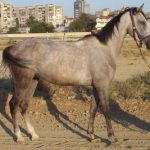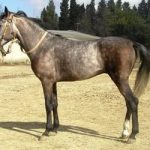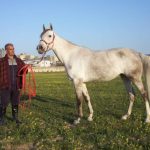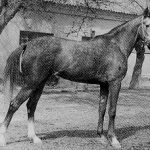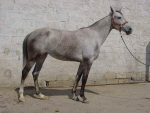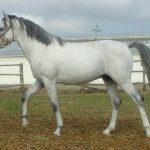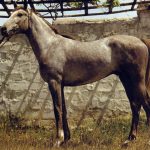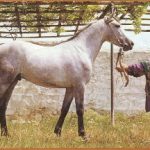Deliboz Horse
The Deliboz, an ancient style Oriental saddle horse breed, developed in and around the regions of Azerbaijan, Georgia, and Armenia many centuries back. This is a common light horse breed that is primarily used for riding and light draft works.
Deliboz Horse Pictures
- Deliboz Horse Images
- Deliboz Horse Photos
- Deliboz Horse Pictures
- Deliboz Horse Stallion
- Deliboz Horse
- Delibozskaya
- Deliboz
- Images of Deliboz Horse
Quick Information
| Other Names | Delibozskaya |
| Behavioral Characteristics | Very lively, whimsical, adaptable, somewhat aggressive |
| Physical Traits | The body is massive and ribbed having an excellent top line, while the head is clean, short, and wedge-shaped with large, expressive eyes, a broad forehead, and a slender nose; the neck is compact and heavy, ending in a well-developed chest, and even loins; the legs are clean and well proportioned |
| Coat Colors | Bay, Black, Dun, Grey, Palomino, Buckskin, Chestnut |
| Height/Size | Around 14.2 hands (adult) |
| Weight | Light; up to 1300 pounds |
| Good for New Owners | No |
| Common Uses | Riding, racing, transport |
| Health Problems | Generally healthy with a long lifespan |
| Type | Race horse, Pack horse, Transportation horse |
| Average Speed | 1600 meters in around 2.5 minutes |
| Ancestors (Bloodlines) | Azerbaijan horses, the blood of Persian, Turkmene, Tersk, and Arabian were also introduced |
| Popular Traits | Multi-talented, excellent movement, durable, natural sense of balance, natural pacer |
| Feeding/Diet | General horse diet including hay, grass, grains, etc. |
| Country of Origin | Azerbaijan |
| Associations and Registries | Equestrian Federation of Azerbaijan Republic (Azerbaijani) |
Video: Deliboz Horses in Stables
History and Development
The Deliboz horses have been bred for several centuries in Taus, Kazakh, and Akstafa, and Taus, the regions which all are now a part of modern-day Azerbaijan. The modern Deliboz horse is a descendant of the Azerbaijan Horse, the popular ancient breed that is dramatically decreasing in numbers. The Deliboz breed is famous in the Azerbaijan region, though relatively less prevalent in the rest of the world.
Some earlier publications often referred to it as the ‘Azerbaijan’ and the ‘Kazakh’ horse, resulting in confusion in differentiating them from the breeds with the same name. However, it is the Turkmen and Persian influence that has set the Deliboz horses apart.
In 1943, the first state-run horse breeding cooperative named ‘Gosplemrassadnik’ that was founded with an aim to increase the Azerbaijan horse population used stallions from the Arabians and the Karabakhs for the refinement of the Deliboz breed.
The result was a success, and the Deliboz horses were freed from a few of their coarse characteristics and turned out to be a horse with lots of endurance and stamina, with a better performance in the field of riding.
Again, in the 1950s, the horses were outbred further with the Tersk and the Arabian horses, resulting in the further refinement in its physical features with a distinctly wider forehead and an even narrower muzzle, quite much like the Arabian horses.
Presently, the Dashyuz stud in the Azerbaijan region contains the most substantial number of Deliboz broodmares, while the stud continues with the effort to maintain strict selective breeding between true Deliboz horses.
Interesting Facts
- These horses are known for their dominant racking gait. This is a rare gait that combines both feet on the same side while moving, as opposed to the more common diagonal foot movement, making riding experience more comfortable and smooth to the rider even over long distances.
- The only drawback of these horses is their reportedly uneven temperament, especially the stallions, since they are said to turn aggressive towards their handlers, as well as other horses, from time to time, making it difficult to handle them.
- It is one of the rare horse breeds having a lengthwise fold in the tongue, making it appear to be almost forked.
- The cannon bone girth of the Deliboz horse is larger than any other horse breed.


